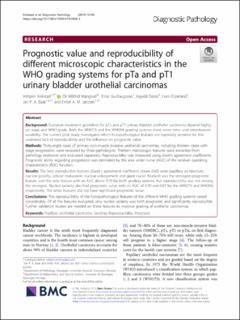| dc.contributor.author | Kvikstad, Vebjørn | |
| dc.contributor.author | Mangrud, Målfrid Ok | |
| dc.contributor.author | Gudlaugsson, Einar | |
| dc.contributor.author | Dalen, Ingvild | |
| dc.contributor.author | Espeland, Hans | |
| dc.contributor.author | Baak, Jan P.A. | |
| dc.contributor.author | Janssen, Emiel | |
| dc.date.accessioned | 2020-04-23T11:34:21Z | |
| dc.date.available | 2020-04-23T11:34:21Z | |
| dc.date.created | 2019-09-05T08:30:12Z | |
| dc.date.issued | 2019-08 | |
| dc.identifier.citation | Kvikstad, V., Mangrud, O.M., Gudlaugson, E. et al. (2019) Prognostic value and reproducibility of different microscopic characteristics in the WHO grading systems for pTa and pT1 urinary bladder urothelial carcinomas. Diagnostic Pathology, 14. | en_US |
| dc.identifier.issn | 1746-1596 | |
| dc.identifier.uri | https://hdl.handle.net/11250/2652223 | |
| dc.description.abstract | Background: European treatment guidelines for pTa and pT1 urinary bladder urothelial carcinoma depend highly on stage and WHO-grade. Both the WHO73 and the WHO04 grading systems show some intra- and interobserver variability. The current pilot study investigates which histopathological features are especially sensitive for this undesired lack of reproducibility and the influence on prognostic value. Methods: Thirty-eight cases of primary non-muscle invasive urothelial carcinomas, including thirteen cases with stage progression, were reviewed by three pathologists. Thirteen microscopic features were extracted from pathology textbooks and evaluated separately. Reproducibility was measured using Gwet’s agreement coefficients. Prognostic ability regarding progression was estimated by the area under curve (AUC) of the receiver operating characteristics (ROC) function. Results: The best reproducible features (Gwet’s agreement coefficient above 0.60) were papillary architecture, nuclear polarity, cellular maturation, nuclear enlargement and giant nuclei. Nucleoli was the strongest prognostic feature, and the only feature with an AUC above 0.70 for both grading systems, but reproducibility was not among the strongest. Nuclear polarity also had prognostic value with an AUC of 0.70 and 0.67 for the WHO73 and WHO04, respectively. The other features did not have significant prognostic value. Conclusions: The reproducibility of the histopathological features of the different WHO grading systems varied considerably. Of all the features evaluated, only nuclear polarity was both prognostic and significantly reproducible. Further validation studies are needed on these features to improve grading of urothelial carcinomas. Keywords: Papillary urothelial carcinoma, Grading, Reproducibility, Prognosis | en_US |
| dc.language.iso | eng | en_US |
| dc.publisher | BioMed Central | en_US |
| dc.relation.uri | https://diagnosticpathology.biomedcentral.com/track/pdf/10.1186/s13000-019-0868-3 | |
| dc.rights | Navngivelse 4.0 Internasjonal | * |
| dc.rights.uri | http://creativecommons.org/licenses/by/4.0/deed.no | * |
| dc.subject | kreft | en_US |
| dc.subject | carcinoma | en_US |
| dc.subject | oncology | en_US |
| dc.subject | blærekreft | en_US |
| dc.title | Prognostic value and reproducibility of different microscopic characteristics in the WHO grading systems for pTa and pT1 urinary bladder urothelial carcinomas | en_US |
| dc.type | Peer reviewed | en_US |
| dc.type | Journal article | en_US |
| dc.description.version | publishedVersion | en_US |
| dc.rights.holder | © The Author(s). 2019 | en_US |
| dc.subject.nsi | VDP::Medisinske Fag: 700::Klinisk medisinske fag: 750::Onkologi: 762 | en_US |
| dc.source.pagenumber | 8 | en_US |
| dc.source.volume | 14 | en_US |
| dc.source.journal | Diagnostic Pathology | en_US |
| dc.identifier.doi | 10.1186/s13000-019-0868-3 | |
| dc.identifier.cristin | 1721723 | |
| cristin.ispublished | true | |
| cristin.fulltext | original | |
| cristin.qualitycode | 1 | |

